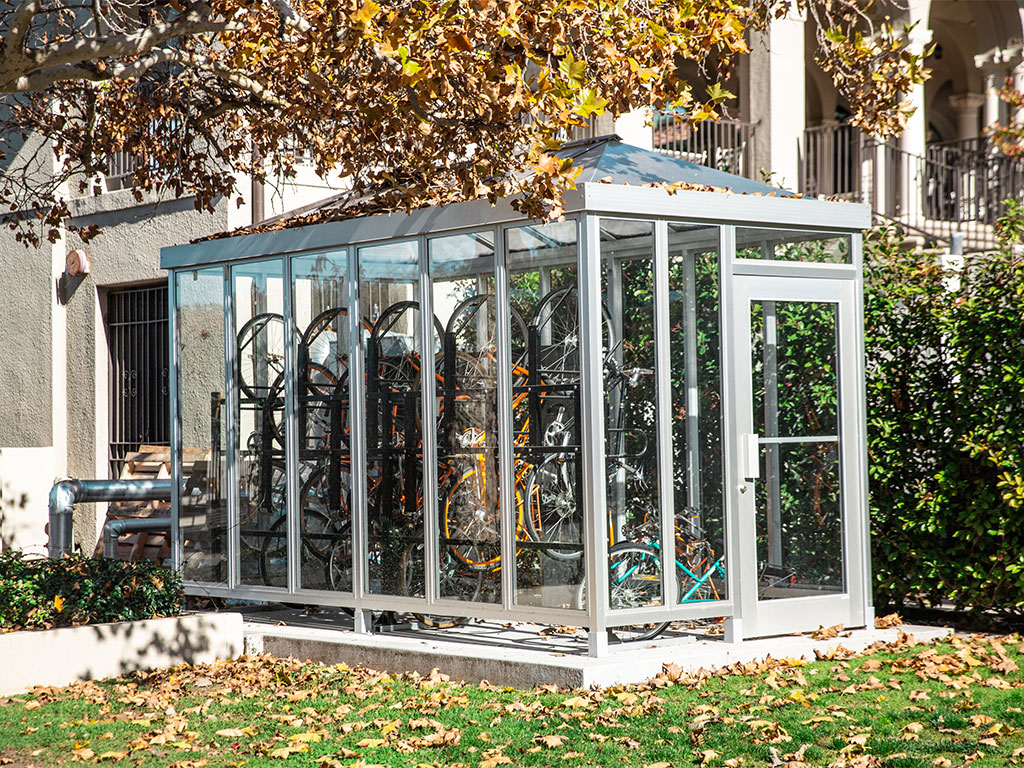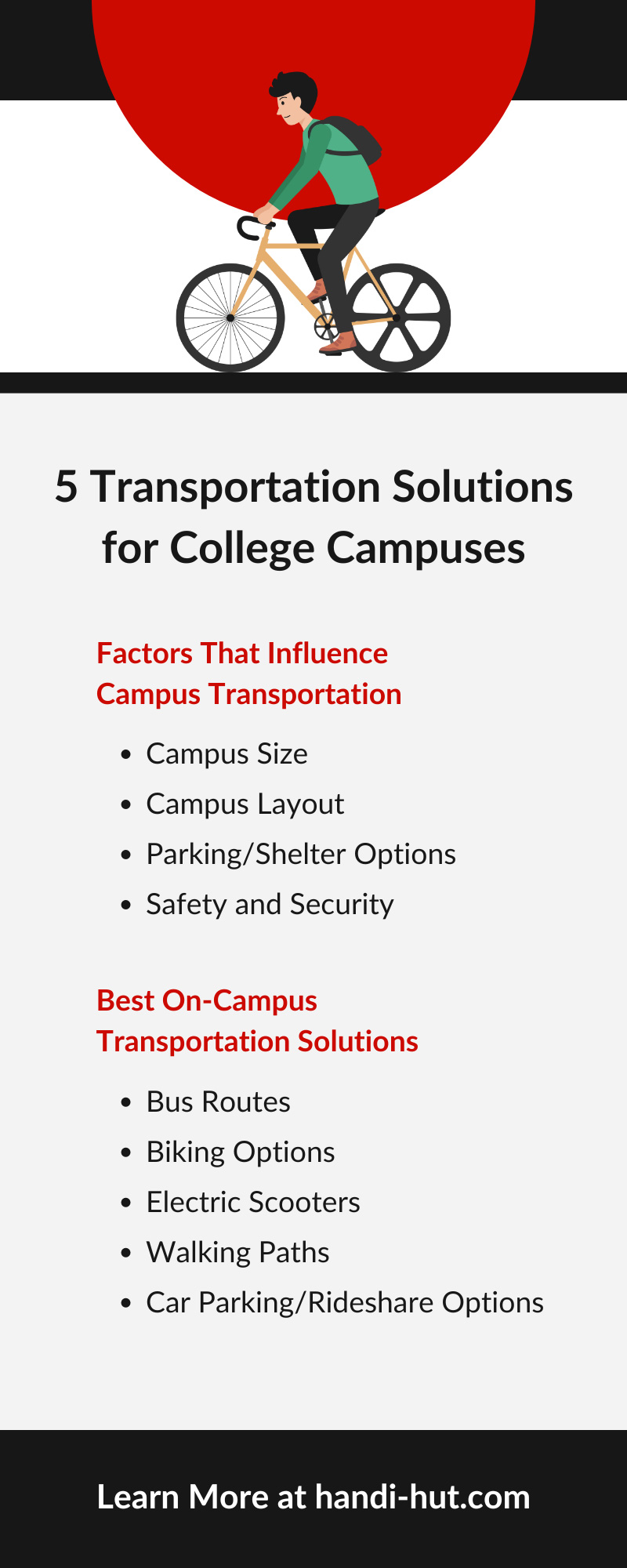
Efficient transportation is a critical component of a well-functioning college campus. Campus transportation influences students, faculty, and staff and their daily convenience and experiences. A well-functioning transportation system or lack thereof also impacts the institution’s operation and reputation. This guide explores the factors that influence campus transportation, the best on-campus transportation solutions, and provides insights on how to optimize your campus for transportation efficiency. If you’re ready to evaluate and improve your campus’ transportation, start here.
Factors That Influence Campus Transportation
Several factors, such as campus size and layout, come into play when considering transportation solutions for college campuses. These components largely determine the effectiveness and practicality of various transportation options. Campus administrators and transportation planners should consider the following details to determine the most valid transportation options.
Campus Size
The size of a campus significantly influences transportation needs. Large campuses often require robust transportation systems to ensure students move efficiently between classes, residence halls, dining facilities, and other campus amenities. Smaller campuses might benefit from simpler, more focused transportation solutions. Therefore, understanding the scale and scope of your campus is the first step in designing an effective transportation plan.
Campus Layout
A campus’s layout includes its geographic spread, the arrangement of buildings, and the accessibility of key areas. A well-planned layout can enhance transportation efficiency by minimizing travel distances and congestion. Conversely, poorly designed layouts can lead to bottlenecks and increased travel times. Planners must consider whether the campus layout supports natural flow and connectivity to facilitate quick, easy movement from one point to another.
Parking/Shelter Options
Adequate parking and shelter options are vital components of campus transportation. Many students and staff rely on personal vehicles, making ample parking essential. Additionally, shelters for bikes, scooters, and pedestrian pathways protect users from weather conditions and encourage alternative transportation modes. Evaluating parking and shelter availability and convenience can help design a comprehensive transportation strategy.
Safety and Security
Safety and security are paramount when developing transportation solutions. Ensuring that all transportation modes, whether buses, bikes, or walking paths, are safe is crucial for the well-being of campus community members. This includes well-lit pathways, secure bike racks, monitored parking lots, and reliable transportation schedules. Addressing safety concerns can also increase sustainable transportation participation and reduce reliance on personal vehicles.
Best On-Campus Transportation Solutions
Once you’ve thoroughly evaluated these factors, it’s essential to explore the various transportation solutions college campuses have at their disposal. Each solution offers unique benefits and can fit a specific institution’s unique needs. Here are some of the most common campus transportation options.
Bus Routes
Establishing efficient bus routes is a common transportation solution for large campuses. Buses can accommodate a significant number of passengers and reduce traffic congestion. They provide reliable transportation across various campus locations and can provide features such as Wi-Fi and real-time tracking to enhance the user experience. Implementing a well-structured bus system can significantly improve accessibility and reduce the need for personal vehicles.
Biking Options
Biking is an eco-friendly and cost-effective transportation option that promotes physical activity among students and staff. It reduces fossil fuel reliance, lowers transportation costs, and contributes to a healthier lifestyle. To encourage biking, campuses should invest in well-maintained bike lanes that ensure safety and convenience for cyclists, secure bike racks to protect against theft, and bike-sharing programs that make bicycles accessible to everyone.
Additionally, providing educational programs on bike safety, such as workshops and seminars, can further promote bike usage and ensure that everyone is aware of the best practices for safe cycling. Consider installing bicycle shelters with innovative security measures and educational materials on how to deter bicycle theft and practice safe cycling.
Electric Scooters
Electric scooters have gained popularity as a quick and convenient mode of transportation on college campuses. They offer an efficient alternative for short-distance travel and can easily integrate into existing transportation systems. To successfully implement electric scooters, campuses should designate specific parking areas and establish clear scooter usage guidelines. This ensures organization and minimizes potential safety hazards.
Walking Paths
Walking remains one of the most fundamental and effective transportation methods on college campuses. Developing well-maintained walking paths that connect key areas of the campus encourages walking and reduces the need for other transportation modes. Make sure to design walking paths to be accessible, well-lit, and with directional signage to guide users. Walking promotes a healthy lifestyle and fosters a sense of community as students and staff interact while traversing the campus.
Car Parking/Rideshare Options
While promoting sustainable transportation methods is essential, provisions for car parking and rideshare options are equally important. Strategically located parking lots can reduce congestion and enhance convenience for those who rely on personal vehicles. In addition, rideshare programs can be promoted to reduce the number of cars on campus, minimizing traffic and parking challenges. Implementing carpool incentives and designated rideshare drop-off zones also optimizes transportation efficiency.
How to Optimize Your Campus for Transportation
Optimizing transportation on a college campus involves a multifaceted approach that aligns with the institution’s unique needs and goals. First, conducting a comprehensive transportation assessment can identify existing challenges and areas for improvement. Engaging with users, including students, faculty, and staff, provides valuable insights into their transportation preferences and requirements. This collaborative approach ensures user-centric and widely accepted solutions.
Investing in technology can significantly enhance transportation efficiency. Real-time tracking systems for buses, bike-sharing programs, and electric scooters improve reliability and user convenience. Mobile apps can provide users with up-to-date information on transportation schedules, availability, and routes, letting them plan their journeys effectively.
Furthermore, sustainability should be a key consideration in transportation planning. Develop initiatives that promote eco-friendly transportation methods, such as biking, walking, and electric scooters, to support a campus’s broader environmental goals. Incorporating green infrastructure, such as solar-powered charging stations and pedestrian-friendly pathways, upholds the institution’s sustainability commitment and attracts environmentally conscious students and staff.
Finally, continuous monitoring and evaluation are essential for maintaining and improving transportation systems. Regularly collecting data on transportation usage, user satisfaction, and operational efficiency allows administrators to make informed decisions and implement any necessary adjustments. This proactive approach ensures that the transportation solutions remain effective and responsive to changing needs and circumstances.
Efficient transportation solutions are integral to the smooth operation and overall experience on college campuses. By understanding the factors that influence transportation, exploring various on-campus solutions, and optimizing the transportation system, institutions can create an environment that supports accessibility, sustainability, and community engagement.
If you’re a campus planner looking for ways to increase alternative modes of transportation, respond to community feedback, and increase sustainability, consider installing bicycle shelters from Handi-Hut. We provide high-quality, durable shelters to support campuses and cities who are looking for these critical transportation solutions.

